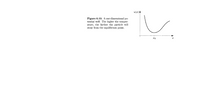Consider a classical particle moving in a one-dimensional potential well u(x), as shown in Figure 6.10 (attached). The particle is in thermal equilibrium with a reservoir at temperature so the probabilities of its various states are determined by Boltzmann statistics.
If we keep the cubic term in the Taylor series as well, the integrals in the formula for x become difficult. To simplify them, assume that the cubic term is small, so its exponential can be expanded in a Taylor series (leaving the quadratic term in the exponent). Keeping only the smallest temperature-dependent term, show that in this limit x differs from X0 by a term proportional to kT. Express the coefficient of this term in terms of the coefficients of the Taylor series for u(x).

Trending nowThis is a popular solution!
Step by stepSolved in 4 steps

- Consider a wavefunction Ψ0 prepared at t = 0 in an infinite square well of width L, such that Ψ0 = N in the interval −L/8 < x < L/8 and is zero otherwise, as illustrated below. found in image Figure 3: A wavefunction Ψ0, prepared in an infinite square well at time t = 0. a) Derive an expression for the normalization constant N, in terms of L. b) The wavefunction of this system at time t can be written as Ψ(x,t) = Pn cnψn(x)e−iEnt/~, where {cn} are a set of constants and {ψn(x)} are the set of energy eigenstates of the well. Use this equation to derive an expression for the cn in terms of Ψ0 and ψn(x). c) The energy eigenstates in the infinite square well are given by found in image Use these equations to derive expressions for the first five of the cn defined in part b) (i.e. derive expressions for c1, c2, c3, c4 and c5). d) Calculate new expressions for the cn if the constant initial wavefunction Ψ0 were changed so that it was restricted to have non-zero values…arrow_forwardFast answerarrow_forwardIn this question we will consider a finite potential well in which V = −V0 in the interval −L/2 ≤ x ≤ L/2, and V = 0 everywhere else (where V0 is a positive real number). For a particle with in the range −V0 < E < 0, write and solve the time-independent Schrodinger equation in the classically allowed and classically forbidden regions. Remember to keep the wavenumbers and exponential factors in your solutions real!arrow_forward
- (a) Write down the wave functions for the three regions of the potential energy barrier (Figure 5.25) for E < U₁. You will need six coefficients in all. Use complex exponential notation. (b) Use the boundary conditions at x = 0 and at x = L to find four relationships among the six coeffi- cients. (Do not try to solve these relationships.) (c) Sup- pose particles are incident on the barrier from the left. Which coefficient should be set to zero? Why?arrow_forwardNow consider a system too big for your program to handle: it has a total of 10000 oscillators, with 3000 quanta to be distributed between them. Block 1 has 7000 oscillators, and block 2 has 3000 oscillators. Think about what you observed above. For the most probable distribution of energy between the blocks: How many quanta would you expect to find in block 1? quanta in block 1 How many quanta would you expect to find in block 2? quanta in block 2arrow_forwardA particle of mass m is confined within a finite square well of depth V0 and width L.Sketch this potential, together with the form of the wavefunction and probability density for a particle in the lowest energy state. Briefly outline the procedure you would follow to determine the total number of energy eigenstates that can exist within a given finite square well.arrow_forward